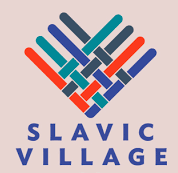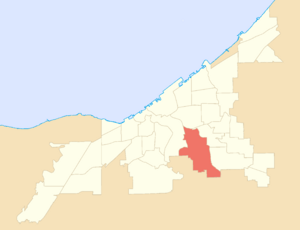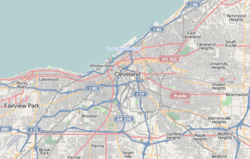Broadway–Slavic Village facts for kids
Quick facts for kids
Broadway–Slavic Village
|
|||||||||||||||||||||
|---|---|---|---|---|---|---|---|---|---|---|---|---|---|---|---|---|---|---|---|---|---|
|
Neighborhood of Cleveland
|
|||||||||||||||||||||
 |
|||||||||||||||||||||
 |
|||||||||||||||||||||
| Country | United States | ||||||||||||||||||||
| State | Ohio | ||||||||||||||||||||
| County | Cuyahoga County | ||||||||||||||||||||
| City | Cleveland | ||||||||||||||||||||
| Population
(2020)
|
|||||||||||||||||||||
| • Total | 20,150 | ||||||||||||||||||||
| Demographics | |||||||||||||||||||||
| • White | 42% | ||||||||||||||||||||
| • Black | 49.9% | ||||||||||||||||||||
| • Hispanic (of any race) | 8.1% | ||||||||||||||||||||
| • Asian and Pacific Islander | 0.4% | ||||||||||||||||||||
| • Mixed and Other | 7.7% | ||||||||||||||||||||
| Time zone | UTC-5 (EST) | ||||||||||||||||||||
| • Summer (DST) | UTC-4 (EDT) | ||||||||||||||||||||
| ZIP Codes |
44105, 44127
|
||||||||||||||||||||
| Area code(s) | 216 | ||||||||||||||||||||
| Median income | $26,407 | ||||||||||||||||||||
|
|||||||||||||||||||||
| Source: 2020 U.S. Census, City Planning Commission of Cleveland | |||||||||||||||||||||
Broadway–Slavic Village is a neighborhood in Cleveland, Ohio. It is located on the southeast side of the city. This area is one of Cleveland's oldest neighborhoods. It started as the township of Newburgh in 1799.
For a long time, many Czech and Polish immigrants made their homes here. Today, the largest part of Broadway is called Slavic Village. This name honors the early communities that settled there.
Broadway is surrounded by other areas. To the west and northwest is Cuyahoga Valley. The Central neighborhood is to the north. To the east are Union–Miles Park and Kinsman. The suburbs of Cuyahoga Heights and Newburgh Heights are to the west and southwest. Garfield Heights is to the south.
Contents
What is Slavic Village?
The historic Slavic Village gets its name from its past. It was once a neighborhood mostly made up of people from Central Europe. The main streets were Fleet Avenue and Broadway.
Slavic Village includes two smaller areas. These were settled by different groups. Karlin was mainly Czech. Warszawa was mostly Polish.
Warszawa: A Polish Community
The Warszawa area was settled by Polish immigrants in 1870. Their lives centered around the small communities they formed. The St. Stanislaus Church was very important to them. This church is located at East 65th Street and Forman Avenue. A busy Polish business area grew along Fleet Avenue and East 71st Street.
The number of Polish and other Central European people in the neighborhood grew. It reached its highest point between the 1920s and 1940s. Then, people started moving to the suburbs. This caused the city's population to drop in the 1950s and 1960s. On November 28, 1980, the Warszawa area was recognized for its history. It was added to the National Register of Historic Places as the Warszawa Neighborhood District.
Bringing the Neighborhood Back to Life
In 1977, people started trying to make the neighborhood better. An organization called Neighborhood Ventures, Inc. was formed. Teddy and Donna Sliwinski, along with architect Kaszimier Wieclaw, helped the area become lively again. To attract people from different Slavic European backgrounds, the region's name was changed to "Slavic Village."
The Slavic Village Assn. was created in 1978. Its goal was to protect homes and businesses. They started the annual Slavic Village Harvest Festival. By 1993, this festival was attracting 100,000 people!
Between 1987 and 1990, the Slavic Village Assn. joined with the Broadway Development Corporation. They became the Slavic Village Broadway Development Corporation. This group worked to improve the Broadway neighborhood. Today, it is known as Slavic Village Development. They have invested a lot of money to improve Slavic Village. They report investing $160 million over 22 years.
Community Efforts and Support
Slavic Village has faced challenges. However, the community has worked together to improve things. In July 2008, Slavic Village was part of a special discussion. It was called "Conversations in Slavic Village." People talked about how important neighborhoods are for a good city. Speakers shared examples of positive things happening in the area. These events showed a different picture than some media reports.
Many different community leaders took part. There was a bank official and a manager from a steel mill. A public art coordinator and a community development director also joined. Leaders from a local park, a youth organization, and a cultural center were there too.
The Fleet Branch of the Cleveland Public Library system serves Slavic Village.
More Information
- You can listen to an audio discussion about Slavic Village. It talks about community development. Western Reserve Studies Symposium: College of Arts and Sciences: Case Western Reserve University Western Reserve Studies Symposium: College of Arts and Sciences: Case Western Reserve University
- Learn more about Cleveland's history in The Encyclopedia Of Cleveland History. ISBN: 0-253-33056-4
- Find more links about Slavic Village on DMOZ at Curlie.
 |
Cuyahoga Valley | Central | Kinsman |  |
| Newburgh Heights, Ohio | Union Miles | |||
| Cuyahoga Heights, Ohio | Garfield Heights, Ohio |



